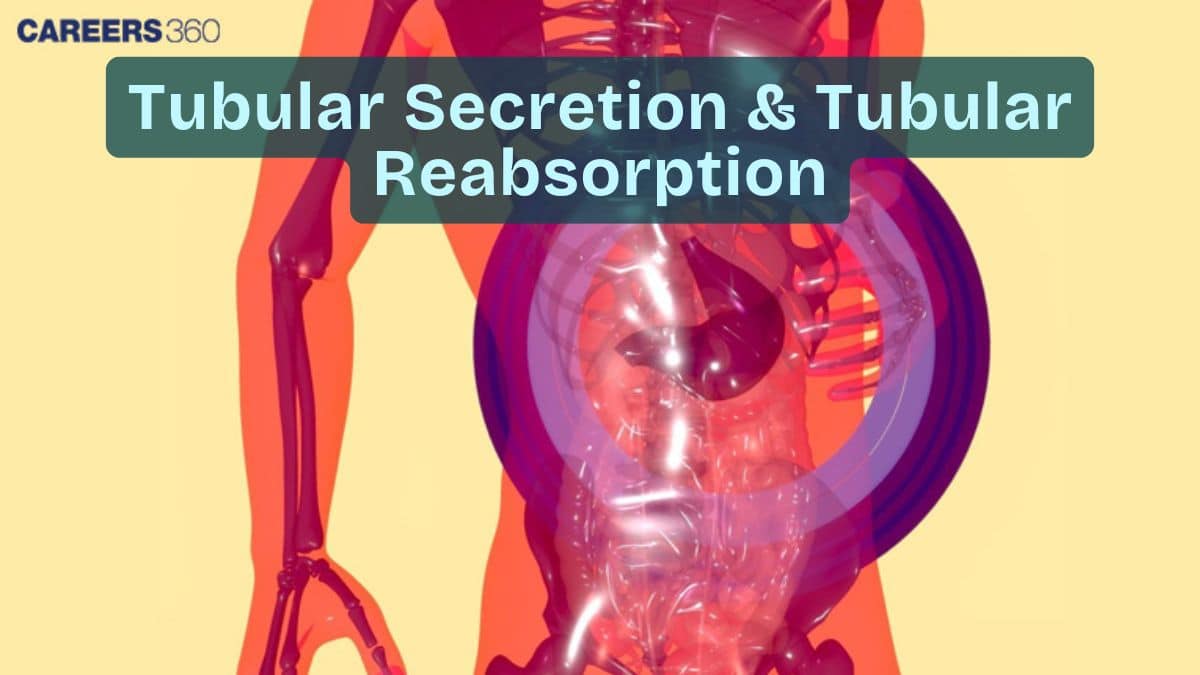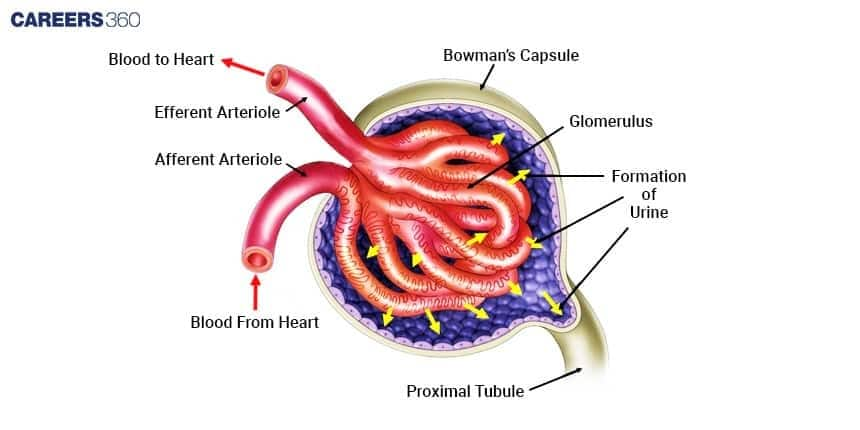Tubular Secretion And Tubular Reabsorption: Definition And Difference
Tubular reabsorption and secretion are essential nephron processes that selectively conserve valuable substances while eliminating metabolic waste and maintaining electrolyte and pH balance. Reabsorption involves reclaiming water, ions, and nutrients back into blood, while secretion actively removes H⁺, K⁺, NH₄⁺, drugs, and toxins to fine-tune homeostasis. This guide covers nephron structure, reabsorption mechanisms, secretion pathways, hormones (ADH, aldosterone), diagrams, FAQs, and NEET MCQs.
This Story also Contains
- What Are Tubular Reabsorption & Tubular Secretion?
- Nephron – Structural Basis of Reabsorption & Secretion
- Tubular Reabsorption
- Substances Reabsorbed
- Tubular Secretion
- Substances Secreted
- Hormonal Regulation of Reabsorption & Secretion
- Tubular Secretion and Reabsorption NEET MCQs (With Answers & Explanations)
- Recommended video on Tubular Secretion And Tubular Reabsorption

What Are Tubular Reabsorption & Tubular Secretion?
It is a vital process in the nephron, which ensures that waste products are excreted and important substances reabsorbed into the bloodstream to maintain the homeostasis of the body. These processes are very basic in balancing electrolytes, flushing out waste products, and thus regulating blood pH, all of which are vital for normal functioning.
Nephron – Structural Basis of Reabsorption & Secretion
Nephron is termed as the functional unit of the kidney. It is a very important structure for filtering blood, reabsorption of important substances back into the blood, and secretion of waste products. There are approximately a million nephrons in each kidney.

Components
It is made up of the following structures:
Glomerulus: The type of capillary bed that is involved in the filtration of the blood
Bowman's capsule: The structure surrounding the glomerulus and into which filtrate enters
Proximal convoluted tubule: The nephron segment is involved in the reabsorption of nutrients, ions, and water.
Loop of Henle: Involved in urine concentration and reabsorption of water and salts back.
Distal convoluted tubule: Further fine-tunes the composition of the fluid that eventually became urine.
Collecting duct: Actual final concentration of urine
Tubular Reabsorption
The process by which the nephron removes water and solutes from the tubular fluid and returns them to the blood. Such reabsorption is essential for the conservation of valuable substances—e.g., glucose—and also for the maintenance of fluid and electrolyte balance.
Transport Mechanisms
It uses both active and passive transport mechanisms to transport the substances from the tubular fluid and enter into the blood.
Active reabsorption implies pumping reabsorbed substances through the membrane (against the gradient of their concentration)
Passive transfer (reabsorption of a substance) delivers the energy of the transfer, which is powered by the gradient of diffusion.
Reabsorption at Different Parts of Nephron
Proximal convoluted tubule: Reabsorbs a very high percentage of filtered water, glucose, amino acids, and ions.
Loop of Henle: Reabsorbs water and salts till the urine has been concentrated.
Distal convoluted tubule: Balances the ion and water concentration.
Collecting duct: Under hormonal control, for example by ADH, which provides variability of the added absorption fraction of water by the needs of a body.
Substances Reabsorbed
A large portion of filtrate is reclaimed as useful substances are selectively reabsorbed back into the bloodstream. This process ensures the conservation of essential nutrients and maintains fluid and electrolyte balance.
Water
Glucose
Amino acids
Na⁺, Cl⁻, HCO₃⁻
Urea (partial)
Tubular Secretion
Tubular secretion is defined as the process through which the nephron adds substances from the blood back into the tubular fluid. It serves to clear the blood and regulate its pH.
Mechanism
An active process where substances are taken out of the blood and added to the tubular fluid, mainly for excretion
Secretion at Different Parts of Nephron
Proximal convoluted tubule: Hydrogen ions, ammonia, and some drugs.
Distal convoluted tubule: Site of potassium and hydrogen ions-secretion
Collecting duct: Secretes hydrogen and potassium ions, for regulating the pH of urine
Substances Secreted
The kidneys secrete certain ions and metabolic wastes into the tubular fluid to maintain acid–base balance and remove harmful substances.
Hydrogen ions
Potassium ions
Creatinine
Drugs
Toxins
Hormonal Regulation of Reabsorption & Secretion
Hormones that regulate reabsorption and secretion are:
ADH (Antidiuretic Hormone)
ADH acts mainly on the collecting ducts, increasing their permeability to water and allowing more water to be reabsorbed into the bloodstream.
This helps conserve body water and concentrate the urine when the body is dehydrated.
Aldosterone
Aldosterone acts on the distal convoluted tubule (DCT) and collecting duct to enhance sodium reabsorption while simultaneously increasing potassium secretion.
This hormone helps regulate blood pressure, blood volume, and electrolyte balance.
Tubular Secretion and Reabsorption NEET MCQs (With Answers & Explanations)
Important questions asked in NEET from this topic are:
Tubular reabsorption
Hormonal regulation of reabsorption and secretion
Practice Questions for NEET
Q1. Out of the following excretory materials, the ones which are not reabsorbed include
Glucose and amino acid
Sulphates and creatinine
Chlorides and phosphates
Sodium and potassium
Correct answer: 2) Sulphates and creatinine
Explanation:
In Tubular Reabsorption in PCT :
Sulphates and creatinine are not reabsorbed.
Sodium and potassium are reabsorbed by the primary active transport.
Glucose and amino acids Sulphates and creatinine are not reabsorbed.
Hence, the correct answer is option 2) Sulphates and creatinine.
Q2. When the volume of body fluid falls below normal, ADH
Decreases permeability of distal convoluted tubule and collecting tubule
Increases permeability of distal convoluted tubule and collecting tubule
Has nothing to do with permeability of convoluted tubule
Decreases permeability of proximal convoluted tubule
Correct answer: 2) Increases permeability of distal convoluted tubule and collecting tubule
Explanation:
ADH can also affect kidney function by its constrictory effects on blood vessels. This causes an increase in blood pressure. An increase in blood pressure can increase the glomerular blood flow and thereby the GFR.
Hence, the correct answer is option 2) Increases permeability of distal convoluted tubule and collecting tubule.
Q3. Which one of the following statements is correct with respect to kidney function regulation?
When someone drinks a lot of water, ADH release is suppressed.
Exposure to cold temperature stimulates ADH release.
An increase in glomerular blood flow stimulates the formation of angiotensin II.
During summer when body loses a lot of water by evaporation, the release of ADH is suppressed
Correct answer: 1) When someone drinks a lot of water, ADH release is suppressed.
Explanation:
Antidiuretic hormone (ADH) plays a crucial role in regulating water balance in the body by facilitating water reabsorption from the distal parts of the nephron (like the collecting ducts), thus preventing excessive urine production (diuresis). When the body’s fluid volume increases, it can signal the osmoreceptors in the hypothalamus to suppress the release of ADH, completing a negative feedback loop. This reduction in ADH release decreases water reabsorption, allowing the excess water to be excreted as urine, helping to maintain homeostasis in the body's fluid levels.
Hence the correct answer is option 1) When someone drinks a lot of water, ADH release is suppressed.
Also Read:
Recommended video on Tubular Secretion And Tubular Reabsorption
Frequently Asked Questions (FAQs)
Tubular reabsorption helps to return useful substances out of the tubular fluids to the blood, whereas the tubular secretion adds waste substances out of the blood to the tubular fluid for excretion.
Commonly reabsorbed substances are water, glucose, amino acids, sodium, potassium, chloride, and bicarbonate.
Hormones like aldosterone control tubular secretion by being responsible for ion transfer; potassium and hydrogen are some of the ions that form the composition of urine and the urine pH.
Abnormal reabsorption and secretion are associated with the disease states of disease including diabetes mellitus, renal tubular acidosis, and abnormalities in electrolytes.